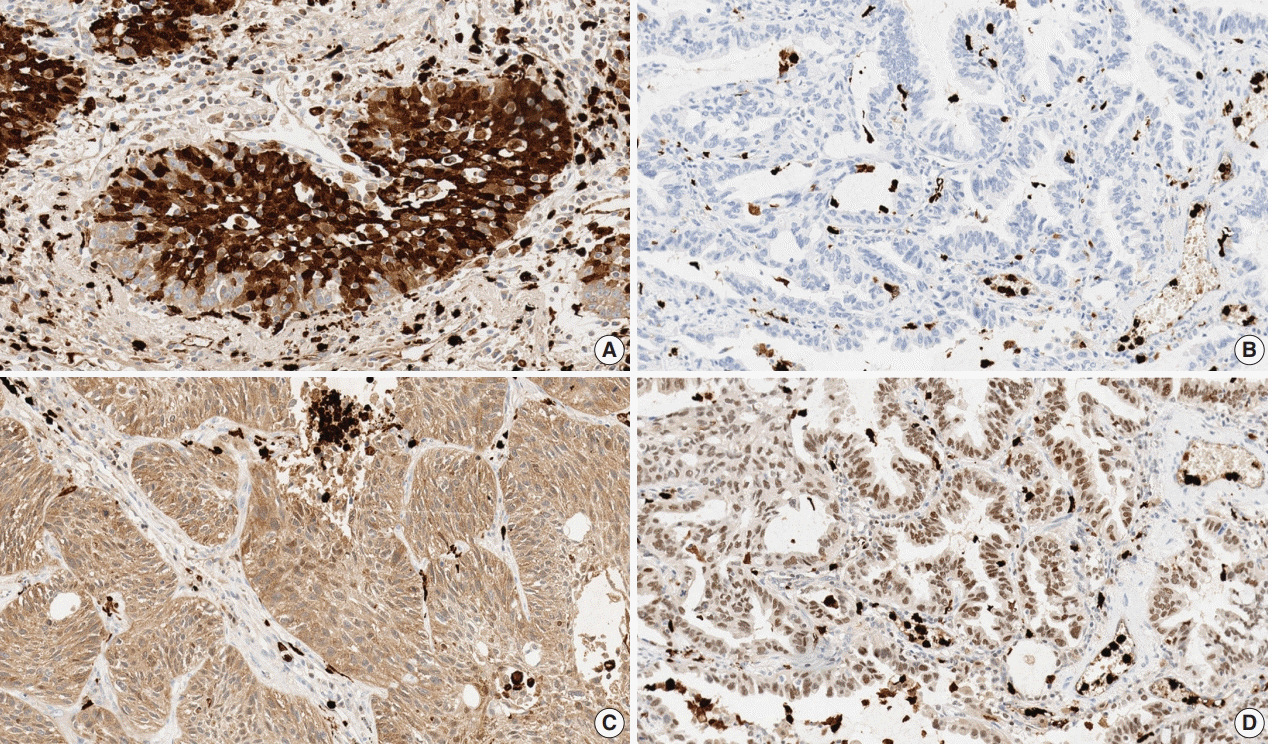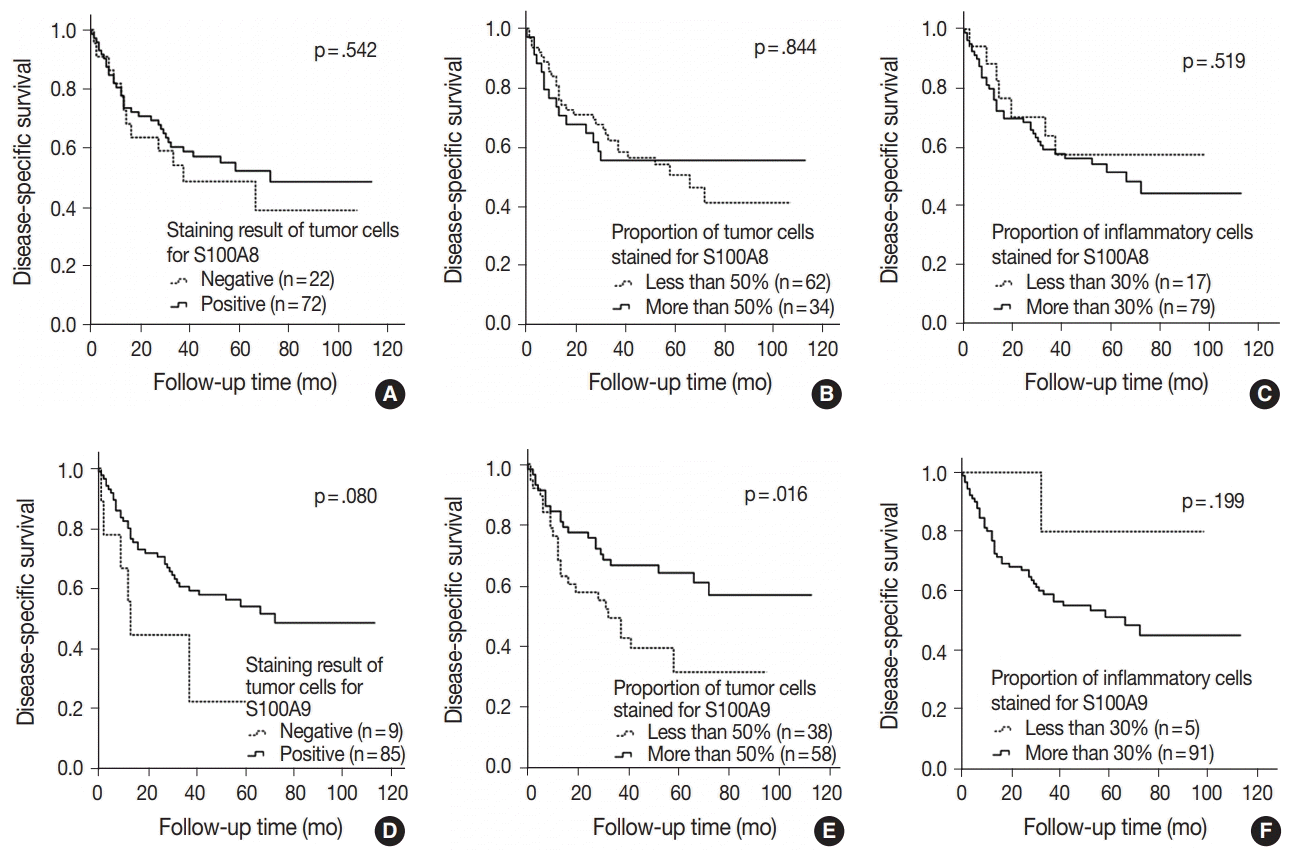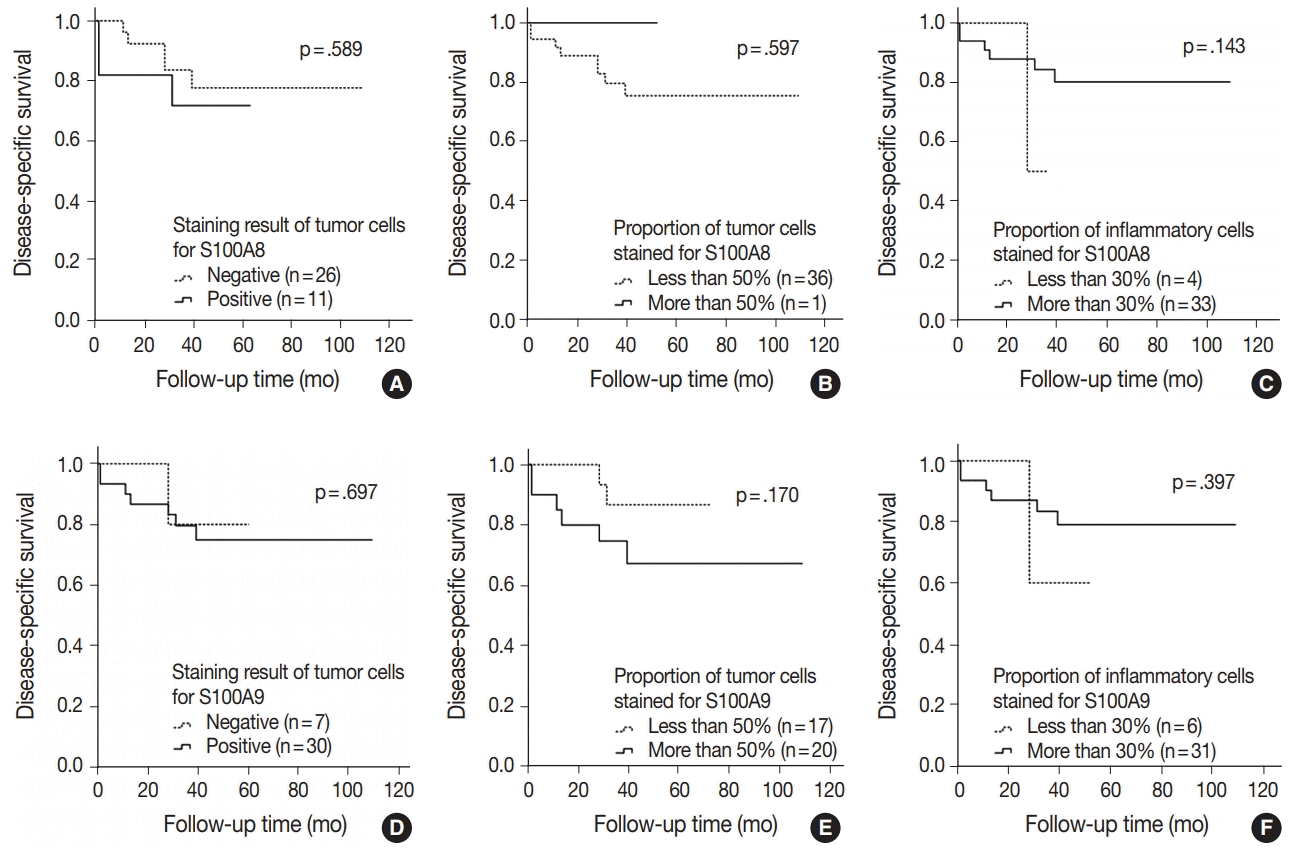MATERIALS AND METHODS
Patients and clinicopathological data
Tissue microarray construction
Immunohistochemistry
S100A8 and S100A9 expressions
 | Fig. 1.S100A8 and S100A9 expressions in non-small cell lung cancer. Tumor cells and inflammatory cells stained for S100A8 in squamous cell carcinoma (A), inflammatory cells stained for S100A8 in adenocarcinoma (B), tumor cells and inflammatory cells stained for S100A9 in squamous cell carcinoma (C), tumor cells and inflammatory cells stained for S100A9 in adenocarcinoma (D). |
Statistical analysis
RESULTS
Patient characteristics
Table 1.
Relationship between S100A8 and S100A9 expressions and clinicopathological characteristics in tumor cells
Table 2.
|
S100A8 expression |
S100A9 expression |
|||||||||||
|---|---|---|---|---|---|---|---|---|---|---|---|---|
|
Staining result of tumor cells |
Proportion of tumor cells stained |
Staining result of tumor cells |
Proportion of tumor cells stained |
|||||||||
| Negative | Positive | p-value | ≤ 50% | > 50% | p-value | Negative | Positive | p-value | ≤ 50% | > 50% | p-value | |
| Age (yr) | .645 | .237 | .334 | .090 | ||||||||
| < 65 | 20 (32.8) | 41 (67.2) | 48 (77.4) | 14 (22.6) | 6 (9.8) | 55 (90.2) | 31 (50.0) | 31 (50.0) | ||||
| ≥ 65 | 31 (36.5) | 54 (63.5) | 59 (68.6) | 27 (31.4) | 13 (15.3) | 72 (84.7) | 31 (36) | 55 (64) | ||||
| Sex | < .001 | .027 | .434 | .867 | ||||||||
| Male | 35 (28.2) | 89 (71.8) | 86 (68.8) | 39 (31.2) | 15 (12.1) | 109 (87.9) | 52 (41.6) | 73 (58.4) | ||||
| Female | 16 (72.7) | 6 (27.3) | 21 (91.3) | 2 (8.7) | 4 (18.2) | 18 (81.8) | 10 (43.5) | 13 (56.5) | ||||
| Smoking | .034 | .450 | .816 | .500 | ||||||||
| Non-smoker | 23 (46) | 27 (54) | 38 (76) | 12 (24) | 7 (14) | 43 (86) | 23 (46) | 27 (54) | ||||
| Smoker | 27 (28.4) | 68 (71.6) | 68 (70.1) | 29 (29.9) | 12 (12.6) | 83 (87.4) | 39 (40.2) | 58 (59.8) | ||||
| Surgery | .024 | .090 | .315 | .783 | ||||||||
| Lobectomy | 49 (38.3) | 79 (61.7) | 97 (74.6) | 33 (25.4) | 18 (14.1) | 110 (85.9) | 55 (42.3) | 75 (57.7) | ||||
| Othersa | 2 (11.1) | 16 (88.9) | 10 (55.6) | 8 (44.4) | 1 (5.6) | 17 (94.4) | 7 (38.9) | 11 (61.1) | ||||
| Histologic type | < .001 | < .001 | .060 | .100 | ||||||||
| SQCC | 22 (23.4) | 72 (76.6) | 62 (64.6) | 34 (35.4) | 9 (9.6) | 85 (90.4) | 38 (39.6) | 58 (60.4) | ||||
| ADC | 26 (70.3) | 11 (29.7) | 36 (97.3) | 1 (12.5) | 7 (18.9) | 30 (81.1) | 17 (45.9) | 20 (54.1) | ||||
| LCN | 3 (37.5) | 5 (62.5) | 7 (87.5) | 1 (12.5) | 3 (37.5) | 5 (62.5) | 6 (75) | 2 (25) | ||||
| Others | 0 | 7 (100) | 2 (28.6) | 5 (71.4) | 0 | 7 (100) | 1 (14.3) | 6 (85.7) | ||||
| TNM stage | .022 | .356 | .503 | .977 | ||||||||
| Ia | 19 (57.6) | 14 (42.4) | 30 (85.7) | 5 (14.3) | 6 (18.2) | 27 (81.8) | 14 (40.0) | 21 (60.0) | ||||
| Ib | 13 (27.1) | 35 (72.9) | 32 (66.7) | 16 (33.3) | 7 (14.6) | 41 (85.4) | 22 (45.8) | 26 (54.2) | ||||
| IIa | 4 (36.4) | 7 (63.6) | 9 (81.8) | 2 (18.2) | 2 (18.2) | 9 (81.8) | 4 (36.4) | 7 (63.6) | ||||
| IIb | 10 (25.0) | 30 (75.0) | 26 (65.0) | 14 (35.0) | 2 (5.0) | 38 (95.0) | 15 (37.5) | 25 (62.5) | ||||
| IIIa | 1 (25.0) | 3 (75.0) | 3 (75.0) | 1 (25.0) | 0 | 4 (100) | 2 (50.0) | 2 (50.0) | ||||
| IIIb | 2 (25.0) | 6 (75.0) | 5 (62.5) | 3 (37.5) | 2 (25.0) | 6 (75.0) | 4 (50.0) | 4 (50.0) | ||||
| IV | 2 (100) | 0 | 2 (100) | 0 | 0 | 2 (100) | 1 (50.0) | 1 (50.0) | ||||
Values are presented as number (%).
Specimens of two patients were not informative for staining result of tumor cells in S100A8 and S100A9 expressions, due to loss of the specimen.
SQCC, squamous cell carcinoma; ADC, adenocarcinoma; LCN, large cell neuroendocrine carcinoma; TNM, tumor-node-metastasis.
Relationship between proportion of inflammatory cells stained for S100A8 and S100A9 and clinicopathological characteristics
Table 3.
|
Proportion of inflammatory cells stained for S100A8 |
Proportion of inflammatory cells stained for S100A9 |
|||||
|---|---|---|---|---|---|---|
| ≤ 30% | > 30% | p-value | ≤ 30% | > 30% | p-value | |
| Age (yr) | .022 | .803 | ||||
| < 65 | 4 (6.5) | 58 (93.5) | 5 (8.1) | 57 (91.9) | ||
| ≥ 65 | 17 (19.8) | 69 (80.2) | 6 (7) | 80 (93) | ||
| Sex | .075 | < .001 | ||||
| Male | 15 (12) | 110 (88) | 5 (4) | 120 (96) | ||
| Female | 6 (26.1) | 17 (73.9) | 6 (26.1) | 17 (73.9) | ||
| Smoking | .356 | .031 | ||||
| Non-smoker | 9 (18) | 41 (82) | 7 (14) | 43 (86) | ||
| Smoker | 12 (12.4) | 85 (87.6) | 4 (4.1) | 93 (95.9) | ||
| Surgery | .748 | .526 | ||||
| Lobectomy | 18 (13.8) | 112 (86.2) | 9 (6.9) | 121 (93.1) | ||
| Othersa | 3 (16.7) | 15 (83.3) | 2 (11.1) | 16 (88.9) | ||
| Histologic type | .283 | .109 | ||||
| SQCC | 17 (17.7) | 79 (82.3) | 5 (5.2) | 91 (94.8) | ||
| ADC | 4 (10.8) | 33 (89.2) | 6 (16.2) | 31 (83.8) | ||
| LCN | 0 | 8 (100) | 0 | 8 (100) | ||
| Others | 0 | 7 (100) | 0 | 7 (100) | ||
| TNM stage | .411 | .163 | ||||
| Ia | 2 (5.7) | 33 (94.3) | 1 (2.9) | 34 (97.1) | ||
| Ib | 7 (14.6) | 41 (85.4) | 4 (8.3) | 44 (91.7) | ||
| IIa | 2 (18.2) | 9 (81.8) | 2 (18.2) | 9 (81.8) | ||
| IIb | 8 (20.0) | 32 (80.0) | 3 (7.5) | 37 (92.5) | ||
| IIIa | 0 | 4 (100) | 0 | 4 (100) | ||
| IIIb | 1 (12.5) | 7 (87.5) | 0 | 8 (100) | ||
| IV | 1 (50.0) | 1 (50.0) | 1 (50.0) | 1 (50.0) | ||
Relationship between S100A8 and S100A9 expressions in tumor cells and inflammatory cells
Table 4.
S100A8 andS100A9 expressions and survival analysis
 | Fig. 2.Kaplan-Meier survival analysis of survival curves based on S100A8 and S100A9 expressions in patients with squamous cell carcinoma. The groups with positive staining in tumor cells (A, D), the groups with more than 50% of the tumor cells (B, E) stained and the groups with less than 30% of the inflammatory cells (C, F) stained for S100A8 and S100A9 reveal a tendency towards increased survivability compared with the groups showing negative staining, less than 50% of the tumor cells stained and more than 30% of the inflammatory cells stained. |
Table 5.
| Variable |
Squamous cell carcinoma |
Adenocarcinoma |
||||||
|---|---|---|---|---|---|---|---|---|
|
DFS |
DSS |
DFS |
DSS |
|||||
| HR (95% CI) | p-value | HR (95% CI) | p-value | HR (95% CI) | p-value | HR (95% CI) | p-value | |
| Univariate analysis | ||||||||
| Age (< 65 yr vs ≥ 65 yr) | 1.402 (0.784–2.506) | .247 | 1.170 (0.635–2.157) | .614 | 0.934 (0.296–2.945) | .934 | 0.818 (0.195–3.428) | .784 |
| Sex (male vs female) | 0.824 (0.200–3.391) | .789 | 0.398 (0.055–2.895) | .363 | 0.736 (0.234–2.320) | .601 | 0.592 (0.141–2.484) | .474 |
| Smoking history (nonsmoker vs smoker) | 0.644 (0.356–1.164) | .145 | 0.671 (0.355–1.266) | .218 | 0.918 (0.269–3.139) | .892 | 1.690 (0.422–6.764) | .459 |
| Surgical method (lobectomy vs othersa) | 1.562 (0.814–2.998) | .180 | 1.479 (0.730–2.996) | .278 | NAb | NAb | ||
| TNM stage (< IIb vs ≥ IIb) | 1.711 (0.984–2.975) | .057 | 1.966 (1.087–3.558) | .025 | 2.727 (0.867–8.571) | .086 | 2.961 (0.738–11.871) | .126 |
| Proportion of tumor cells stained for S100A9 (≤ 50% vs > 50%) | 0.709 (0.408–1.231) | .222 | 0.491 (0.272–0.889) | .019 | 1.625 (0.475–5.557) | .439 | 2.891 (0.583–14.337) | .194 |
| Multivariate analysis | ||||||||
| Age (< 65 yr vs ≥ 65 yr) | - | - | - | - | - | - | - | - |
| Sex (male vs female) | - | - | - | - | - | - | - | - |
| Smoking history (nonsmoker vs smoker) | - | - | - | - | - | - | - | - |
| Surgical method (lobectomy vs othersa) | - | - | - | - | - | - | - | - |
| TNM stage (< IIb vs ≥ IIb) | 1.736 (0.998–3.022) | .051 | 2.012 (1.110–3.644) | .021 | 2.577 (0.805–8.253) | .111 | 2.528 (0.618–10.336) | .197 |
| Proportion of tumor cells stained for S100A9 (≤ 50% vs > 50%) | 0.702 (0.402–1.224) | .212 | 0.483 (0.265–0.880) | .017 | 1.374 (0.393–4.807) | .619 | 2.457 (0.484–12.484) | .278 |
 | Fig. 3.Kaplan-Meier survival analysis of survival curves based on S100A8 and S100A9 expressions in patients with adenocarcinoma. The groups with positive staining in tumor cells (A, D), the groups with more than 50% of the tumor cells (B, E) stained and the groups with less than 30% of the inflammatory cells (C, F) stained for S100A8 and S100A9 reveal a trend towards decreased survivability compared with the groups showing negative staining, less than 50% of the tumor cells stained and more than 30% of the inflammatory cells stained. |




 PDF
PDF Citation
Citation Print
Print



 XML Download
XML Download